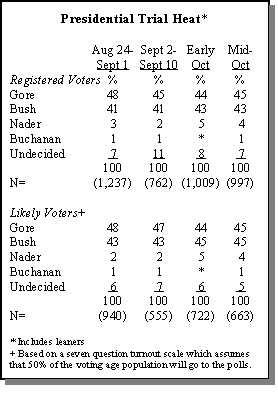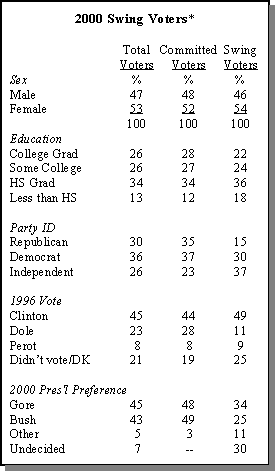Introduction and Summary
With two weeks to go until Election Day, voters still can’t choose between Al Gore and George W. Bush. The perceived strengths and weaknesses of both candidates continue to drive voter indecision. People have a better opinion of the Texas governor personally than they had in September, prior to the debates. At the same time, the vice president continues to inspire more confidence on leading issues than his opponent, as he has since the Democratic convention.

Accordingly, the latest Pew Research Center survey finds virtually no change in voting intentions since early October. Gore draws 45% to Bush’s 43% in the poll of 997 registered voters conducted October 18-22, 2000. When the sample is narrowed to those most likely to vote, it is dead even — 45% to 45%. This is the fourth survey in a series finding only modest differences in candidate standing when turnout is factored into the horse race. Indeed the profile of the likely electorate is not significantly different demographically from what it was in mid-October 1996. (See table page 12.) And now, as in 1996, findings based on likely voters are only slightly more Republican than those which include all registered voters.
But there is clearly the potential for turnout patterns to loom larger this year. The current poll once again finds Gore voters are generally less enthusiastic than Bush backers, and this could result in a wide turnout gap between the two groups. The poll also reveals that swing voters, who by and large lean to Gore, are less likely to turn out than committed voters. These factors could produce a more GOP-leaning electorate by Nov. 7.
Adding to the tightness of the final leg of the campaign, there has been almost no decline in the number of undecided voters and those saying that they might change their minds between now and Election Day. Nearly one-quarter of the electorate (23%) now falls into the swing voter category, with virtually no change in the past two weeks.
Voter uncertainty may have actually increased in response to the debates, as Bush has improved his personal image, yet has been unable to gain more support on top issues. The GOP nominee has narrowed the qualifications gap, is seen as more likable, and as more of a straight shooter than his Democratic rival. Gore faces the opposite problem — his standing on character and personality traits has remained flat or, in some cases, has declined. Since the debates, more people have cited criticisms of Gore’s personality as a reason for not voting for him and many use harsh adjectives to sum him up in one word. But, Gore continues to hold double-digit leads over Bush on health care, Social Security, prescription drug coverage for seniors and stewardship of the economy despite his personal image problems.
Less of a Gender Gap

The gender gap in presidential preference has narrowed slightly in recent weeks. Men now favor Bush over Gore by a smaller margin than they did just a few weeks ago. Similarly, Gore’s lead among women is slightly diminished.
Reflecting the closeness of the race, independents are now breaking narrowly for Bush over Gore: 40%-36%. Partisans remain committed to their party nominees, with 92% of Republicans backing Bush and 85% of Democrats voting for Gore. However, Republican supporters of Bush continue to be much more enthusiastic about their choice, than are Democratic supporters of Gore. Fully 65% of Republicans say they support the governor strongly. Among Democrats, only 47% characterize their support as strong.
As a consequence, Bush holds a slight enthusiasm edge overall. Well over half (57%) of his backers say they support the governor strongly, compared to 48% of Gore’s supporters. Still neither candidate has increased his proportion of strong supporters in recent weeks.
Swing Vote Undiminished

With nearly a quarter of the electorate still up for grabs, the swing vote remains crucial. This pivotal group is defined as those who are undecided, and those who currently prefer one candidate over the other but say there’s a chance they might change their minds. The number of swing voters has shrunk only slightly from 25% in early October to 23% now.
Swing voters are less well-educated than average and very few identify themselves as Republicans. Nearly half voted for Bill Clinton in 1996. They currently favor Gore over Bush by a 34%-25% margin. This is not necessarily good news for the vice president as it reflects the fact that his supporters are somewhat less committed to his candidacy than Bush’s backers. Nearly one-in-five Gore supporters (18%) say there is a chance they might vote for Bush next month. This compares with 13% of Bush voters who say they would consider voting for Gore.
Also, while swing voters as a group may favor Gore, they are less likely than more committed voters to turn out to vote. Therefore, Gore must not only shore up his support among these ambivalent voters, he faces the challenge of making sure they show up at the polls.




